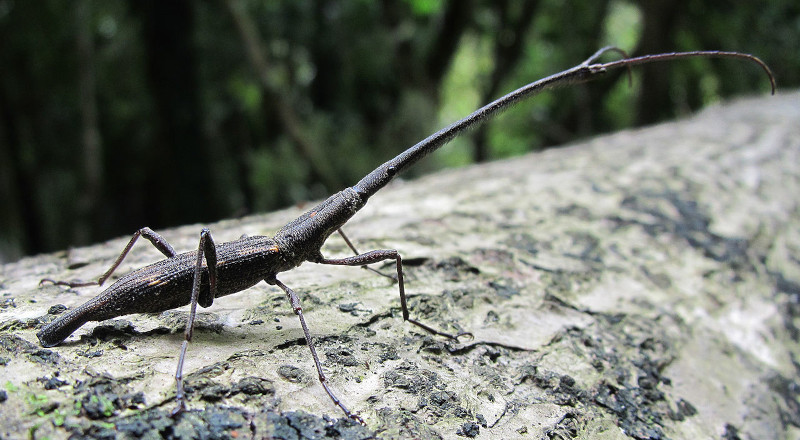New Zealand Giraffe Weevil Facts
- This highly distinctive creation of Nature and evolution typically goes by the informative and descriptive common name of the New Zealand Giraffe Weevil. For the present moment, the remarkable crature has no other accepted common name.
- Scientific professionals, meanwhile, most frequently refer to this natural marvel by its official technicla name. That, however, represents even more of a mouthful than the common name! That’s because it’s known by science as the Lasiorhynchus barbicornis.
- The amazingly evolved Arthropod received that hard to pronounce name at the hands of the renowned Danish entomologist, Johan Christian Fabricius. He accomplished the first formal acknowledgment of it as a separate and distinct species, in the year 1775.
- Regardless of which term one chooses to emply when speaking of it, though, the insect represents an impressive species. It also represents the largest beetle, in terms of length, native to its particular region of the world. That serves to further distinguish it.
- For the moment, the New Zealand Giraffe Weevil appears to be maintaing a population base that’s both sufficient and stable. The IUCN therefore has no listing for the invertebrate on its Red List. That could potentially change in the near future, however.
- This holds true due to the fact that the animal nevertheless does face several potential threats to its continued existence. In this, it’s like most species. Habitat loss forms a possible danger, of course. Climate change, though, likely forms its greatest threat.
Related Articles
New Zealand Giraffe Weevil Physical Description
The fascinating New Zealand Giraffe Weevil easily impresses those who encounter it. It further does so for a variety of reasons. The most obvious one, though, understandably remains its sheer visual appearance. Yet its pure size also merits a measure of note.
That’s due to the simple fact that some individuals attain significant lengths. Like many insects, however, this marvel of Nature also displays the physiological characteristic of sexual dimorphism. That trait manifests itself most spectacularly in terms of body length.
Females of the species rarely exceed 2 in (5 cm) in total length. The males of the species, meanwhile, sometimes reach lengths measuring as much as 3.5 (9 cm). For a beetle, that’s relatively huge! Individuals frequently vary quite significantly in length, however.
In terms of coloring, though, the presentation remains fairly simple. The vast majority of specimens display an almost entirely black or extremely dark brown coloring. Small, widely scattered grayish-white spots also appear, though, in random locations on the body.
The most obvious gender-based difference the New Zealand Giraffe Weevil presents, however, shows in the neck. This further understandbly forms the basis for part of the common name. The neck of the males often reaches many times the length of the female’s.
- Kingdom: Animalia
- Phylum: Arthropoda
- Class: Insecta
- Order: Coleoptera
- Family: Brentidae
- Genus: Lasiorhynchus
- Species: L. barbicornis
New Zealand Giraffe Weevil Distribution, Habitat, and Ecology
The very name of the New Zealand Giraffe Weevil clearly indicates its native habitat range. Unfortunately, though, even within this fairly restricted region of the world, it has a limited range. That’s due to the fact that the invertebrate only appears in portions of the country.
For the moment, it appears to be reasonably widespread across most, if not all, of the North Island. On the South Island, though, its range is much more restricted. There, in fact, it only seems to live in small, isolated parts of the northwestern sections of the island.
The nature of the local ecosystem further plays a pivotal role in that disparity. This unique Arthropod lives almost exclusively in regions of native temperate forest. The animal also displays a marked preference for lower altitudes, as well, with few living higher up.
Within that range and ecosystem, though, it appears to be quite flexible in its choice of specific locations. The distinctive creature inhabits a total of 17 species of trees native to the region. It does seem to have a slight preference for mahoe and karaka trees, however.
This species, in fact, spends most of its entire life in one tiny area of the forest. There, it’s primarily active during the day. During that period, it feeds on the sap of the local trees. At night, though, it typically shelters in the dense canopy for protection from predators.
Females of this incredible species generally lay eggs from October to March, in small holes burrowed into the tree trunk. She lays a single eggs per hole, then covers it with sawdust. Larvae generally spend 2 years burrowing through the bark, feeding on fungus there.
Mature adults of the New Zealand Giraffe Weevil, meanhwile, have a much shorter lifespan than the larval stage. Mature specimens only emerge to mate, during the October to March period, peaking in February. Few live more than a few weeks after their emergence.
Species Sharing Its Range
Yellow Eyed Penguin
Check out our other articles on 5 Obscure United States Geological Gems, Yellow Throated Marten, Padirac Cave, Queen of the Andes, Saltwater Crocodile, Black Rain Frog, Red Rock Crab

